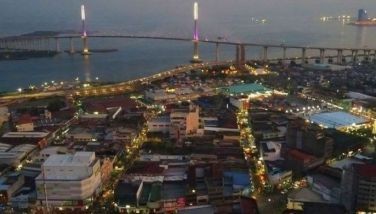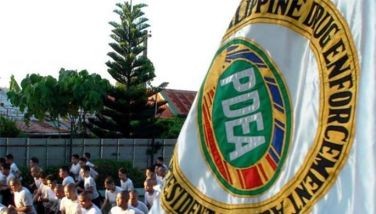Basilica Minore del Santo Niño: Restoring a historical landmark
CEBU, Philippines - The collapse of the belfry of the Basilica Minore del Santo Niño during the October 15, 2013 7.2 magnitude earthquake was heartbreaking for Cebuanos and devotees of the Holy Child.
Being the oldest Roman Catholic church in the country, the basilica has withstood many calamities and the destruction caused by the powerful earthquake shook Cebuanos to the core.
But after dealing with the shock caused by the collapse of the structure, the Augustinian Order shifted to reconstruction mode, hopeful that the structure will be restored.
Not without challenges, though. How should reconstruction go about and how much would it cost? Will the reconstruction be able to withstand earthquakes in the future?
"The challenges encountered at first were the funds and the experts to help rehabilitate the destroyed parts of the complex," said Fr. Harold Rentoria, O.S.A., who was tasked to lead the rehabilitation efforts.
Founded in 1565 by the Augustinian friars, the then San Augustin Church was completed in 1739.
The basilica is one of the national historical landmarks. It is also the home of the oldest religious relic in the country, the wooden image Santo Niño de Cebu.
Given its historical and cultural value, Rentoria said the National Historical Commission of the Philippines got on board and helped address the challenges, especially on the funds to support the entire restoration process.
The NHCP allocated almost P14 million from its 2015 budget under the national government's heritage recovery program of sites and structures damaged by the 2013 earthquake for the restoration of the belfry and the basilica's façade.
The restoration of the Basilica Minore del Santo Niño de Cebu was one of the 16 projects facilitated by NHCP in Cebu province in 2015.
A team from the Association of Structural Engineers of the Philippines led by seismic engineering specialist Carlos Villaraza was commissioned by NHCP.
The team was tasked to undertake a study that served as the basis of the national structural code for traditional masonry since the present-day code applies only to reinforced constructions.
The entire pre-restoration phase, which mainly involved planning supported with studies, was allocated a budget of P5 million provided by the Tourism Infrastructure and Enterprise Zone Authority.
Architect Ma. Luisa Valerio, one of the restoration architects of NHCP, said the architectural restoration plan for the basilica was subjected to detailed engineering studies before the actual restoration.
The rubble from the collapsed belfry was subjected to laboratory analysis, too.
"We studied the materials, looking into its composition. We have to analyze the materials. It was a very tedious study since it has to be supported by scientific analysis," said Valerio.
She added that various materials were also tested to see if the new building materials will be compatible to the old and existing structure.
Simultaneous to the studies done was the retrieval, labeling and safekeeping of the debris from the collapsed belfry and the shoring and installation of scaffoldings and other protective measures on site before rebuilding a portion of the belfry.
Valerio said the damaged structure was also examined to determine the cause of the collapse, not only considering the impact from the earthquake but also taking into account possible interventions to be pursued.
She said one of the results from the study revealed that the rubble core, which is at the interior part of the wall, has already loosened and weakened due to external environmental factors.
Considering the old age of the structure, water or moisture has penetrated into the interior part of the wall pulverizing the materials inside.
"After the mechanical and chemical cleaning of the exterior walls, we injected lime water into the rubble core. Kahit mabasa siya, titigas ito ulit. Then we sealed the walls with lime to make it compact," Valerio explained.
Aside from the mechanical and chemical cleaning of the exterior walls, the restoration works included the consolidation of masonry walls, the structural rehabilitation and reconstruction of the belfry that was handled by NHCP's Historic Preservation Division.
The architects, including Valerio, engineers and conservators were tasked to oversee and monitor the projects to their assigned cluster ensuring that the structural standards are met by contractors and workers.
For the reconstruction of the damaged part of the belfry, Valerio said the execution of the engineering work adopted the reinforced concrete construction.
Reinforcing steel bars were first put in place before the materials were fitted and covered with lightweight aggregates used to reduce the weight of the structural concrete.
"We made sure that the load at the top can be carried sufficiently by the (feet of the) tower… We made sure, too, that it will be light-weight so the structure will not resist any ground movement," said Valerio.
She also noted that the heaviest bell of the belfry was moved from the dome to the feet of the bell tower for safety reasons.
"We explained it during the stakeholders meeting that the structure cannot hold the weight of the bell since it's too heavy," she said.
Experts from NHCP also coordinated and held regular dialogues with various stakeholders from the community for consultations and training workshops.
The dialogues engaged the representatives of the religious community in discussions presenting to them the restoration scheme and soliciting opinion or position from them in order to come up with inclusive strategies.
Rentoria supported the decision to move the biggest bell to the feet of the bell tower where a wishing well now also stands. He said the design will be a reminder of one of the greatest challenges that confronted the Catholic religious and faithful.
The entire restoration for the minor basilica stretched for eight months (from June 2015 to January 2016) but the job did not end there.
Less than two months after the structural restoration was completed, the Basilica Minore del Santo Niño de Cebu was officially turned over by the NHCP to the Augustinian community, including the responsibility of maintaining the structure for long-term sustainability of the restored heritage asset.
"After the turnover of the rehabilitated church, the work of the Augustinian community is to properly maintain the church complex following the NHCP guidelines for a national historical landmark," said Rentoria.
The NHCP recommended the necessary conservation measures to maintain the grandeur of the restored minor basilica such as the regular cleaning and housekeeping; and the reappointing of mortar joints to prevent water seepage inside the masonry. The local Augustinian community was also advised to inspect and document the state of the structure at least twice a year; repair and replace minor damage on stone work to secure the structural safety of the walls; and remove vegetal growth on the stone masonry to prevent material damage.
The NHCP, on the other hand, will also conduct its separate post-evaluation to verify the effectiveness of the methodologies applied during the restoration process.
While slowly recovering from the unfortunate event, Rentoria said the people now have come to recognize and appreciate the importance of conserving heritage that reflects the religious traditions and customs of the locals.
He likened the basilica to a historical treasure that has to be preserved as it has kept the long-time religious practices of the people that continue to flourish at present.
Just as the structure has been restored from the damage caused by the quake, the Catholic faithful also found themselves drawn back to the church, mending their spiritual affirmation, he said.
"The earthquake has strengthened the faith of the people especially the devotees of the Santo Niño. We have observed the increase in the mass goers on Fridays and Sundays," Rentoria recalled.
Even if it stands vulnerable to the extreme weather conditions, the minor basilica continues to be of value because of the people's firm belief that their faith could not be shaken. (FREEMAN)
- Latest























